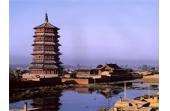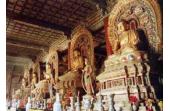Datong City, located in the north of Shanxi Province about 240
kilometers due west of Beijing and some 20 kilometers south of the
Great Wall, which follows, roughly, the border between present-day
Shanxi Province and Inner Mongolia Autonomous Region, is one of the famous historic and cultural cities of China. In ancient times, Datong was a military stronghold whose mission
was to hold back the hordes that frequently pushed south into China
proper, from Mongolia. Indeed, this was the very raison d'être of
the Great Wall. Today, however, Datong, alongside its
tourism-oriented role as an important Chinese historical venue,
provides one of the country's primary sources of energy, as
significant coal deposits have been found here, giving Datong the
somewhat dubious title of China's "coal capital".
- View Mia's travel story in Shanxi with pictures
But the city of Datong is of course more than just a burgeoning
industrial zone, it boasts a unique landscape and is the venue of
some of China's most valued historical treasures, such as: Yungang
Grottoes (see the link to Yungang Grottoes here); Hengshan
Mountain, one of the five sacred mountains in Taoism/ Daoism; the Nine-Dragon Screen Wall, the largest dragon screen wall in China; the Hanging Temple, a
Buddhist temple complex built into a cliff face that is both a
thing of beauty and a marvel of engineering; the Wooden Pagoda of
Fogong Temple, the oldest and tallest wooden pagoda in China; Shanhua Temple, whose buildings and statues date back to the Liao (CE 916-1125)
and Jin (CE 1115-1234) Dynasties; Daxiong Palace, one of the largest ancient Buddhist shrines in China, and Bojia
Palace, whose statues also date back to the Liao Dynasty, both of
which palaces belong to the Huayan Temple complex, as does Tiangong
Pavilion, making Datong City rich in cultural heritage.
In addition to these cultural highlights, Datong City has a past
that is also linked to the overland Silk Road route (to distinguish
it from the later "Silk Road" sea route). The city was founded
around BCE 200 during the Han (BCE 206 – CE 220) Dynasty under the
name Pingcheng. Pingcheng was a stopping-off point for camel
caravans heading west along the Silk Road route.












